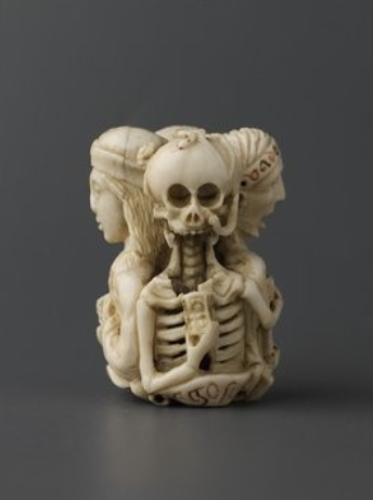Objects such as this tiny book-shaped pendant, made of silver with pages showing scenes from scripture, are somewhat mysterious. Possibly intended to be attached to a rosary, this locket may also have been worn on a chain around the neck, as jewellery. On the one hand, then, this charming little object functioned as an aid to private piety, focusing the eyes, hand, and mind on Christ, keeping a small ‘space’ for religious devotion in close proximity to the wearer. On the other hand, however, it might have served as a form of personal adornment: a fashionable and attractive novelty intended to elicit admiration. As such, the pendant is a paradox: it is intended to encourage spiritual reflection but it might also be an expression of sinful vanity.
The memento mori rosary bead from France embodies the dangers of such vanities. Its purpose is to remind believers of the inevitability of death and judgement, and the ephemerality of worldly pleasures. In fact, unease about the afterlife reached fever-pitch in the sixteenth century, as Protestants rejected Catholic doctrine and practices relating to death, including the notion that individuals could increase their chances of going to heaven by performing good works in life, or through the intercessory prayers of loved ones. Radical Reformers emphasised the doctrine of predestination associated with the theologian John Calvin, according to which an individual’s ultimate fate – heaven or hell – was predetermined by God. Death became the great unknown, and individuals searched anxiously within themselves for evidence of salvation.












